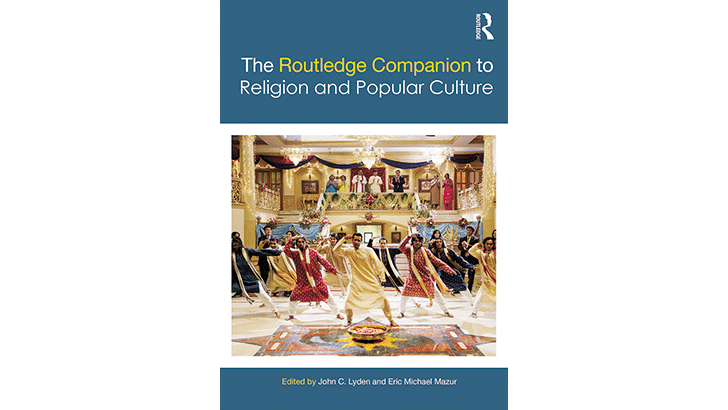The State of the Study of Religion and Popular Culture
The Routledge Companion to Religion and Popular Culture
Edited by John C. Lyden and Eric Michael Mazur
Routledge: New York, 2015, $240.00
The Routledge Companion series provide an overview to the study of a wide range of fields, approaches, topics, and figures. The Companion volumes typically provide an introduction to the subject matter which puts the current discussion in a historical context, offer a structure for organizing the discussion of the topic, and essays by authors from a variety of perspectives within their organizing structure. Though typically too expensive to use as textbooks, the volumes have developed a reputation as rich and trustworthy introductions of a topic that bring together diverse voices in the field and serve as helpful research sources.
The Routledge Companion to Religion and Popular Culture illustrates the breadth of attention scholars who study religion are giving to popular culture and provides an opportunity to reflect on the range and development of this discourse. It should quickly become a standard source book for those interested in the topic and belongs in the libraries of colleges, seminaries, and universities where the subject is being taught or researched. The editors are respected figures in the study of religion and popular culture: Lyden is known particularly for his contributions to the study of religion and film and Mazur as the editor of one of the standard textbooks on religion and popular culture.
In Part I, Lyden and Mazur offer introductory essays discussing the development of interest in religion and popular culture, speculate about the reasons for attention to the topic, and consider its growing acceptance as a scholarly topic over the last twenty-five years. These are useful essays that put the rest of the volume in context.
I do, however, raise a couple of cautions about the editors’ portrayal of the discussion of religion and popular culture today. First, the editors give attention to the longstanding complaint that the study of popular culture has not been respected in the academy. There was clearly a time when religious studies resisted attention to popular culture, but it is hard to sustain the argument today. Presentations related to popular culture appear in many AAR/SBL groups, and journals and many books on the topic give evidence to its place in academic discourse. Indeed it is the popularity of the topic with both scholars and students that demonstrates the need for this volume. It seems more accurate to note that popular culture studies are a part of a broader trend that focuses on religion in everyday life.
Secondly, as is increasingly common, the editors discuss the attention to religion and popular culture as though it marked the emergence of a new field. But, this area of study has no distinctive methodologies. It draws, as the volume demonstrates, on religious, literary, media, and cultural studies. Would it not be more accurate to think of the interface of religion and popular culture as an important location for the interdisciplinary study of religion rather than as a field?
Part II draws attention to advances in our understanding of what constitutes popular culture. Much of the early study of popular culture, both in religious studies and more generally, was carried out by people who were trained as textualists. Thus they focused on popular film, television, music, and novels, engaging them as literary narratives which might be about religion or be interpreted in light of theological themes and images. By organizing the essays into three sections that distinguish between what they call “mediated,” “material,” and “locative” encounters between religion and popular culture, the editors draw attention not only to popular narratives but to the aesthetics and economics of the media technologies through which they communicate; to food, fashion and other popular “stuff;” and to spatially located events and activities such as consumption, sports, and civil religion. This latter attention to events and activities reminds us that the audiences who we once treated only as consumers, and whom we too often assumed interpreted these “texts” in the same way we critics did, in fact have complex relationships with popular culture sometimes adopting and adapting it in nonhegemonic ways.
Helpful as it is for the structure of volume to remind us that popular culture is more than popular narrative, we ought to ask why [the editors consider] novels, comics, and graphic novels to be “material” rather than “mediated” encounters between religion and popular culture. Doing so encourages the assumption that media is something that emerges with radio, television, film or perhaps the Internet. But writing and print, and speech for that matter, are also forms of media and part of the mediation process.
Part III then turns to the way that a wide array of religious traditions and movements have been presented in popular culture. The editors suggest, with good evidence, that popular culture has primarily been created and studied by people shaped by Protestant Christianity, and they are careful to ask how popular culture has presented other traditions. Further they ask how those traditions interpret popular culture.
The book illustrates the increased attention to the “circuit of culture” that is evident in the study of religion and popular culture, reminding the reader to attend both to the cultural and economic systems that produce popular culture and to the creative involvement of those once assumed to be passive consumers of the popular. It is impossible in a brief review to give individual attention to the twenty-six essays that make up Parts II and III. But they are quite remarkable in their range, method, and focus. The collection includes a number of writers long respected for their work on a range of aspects of religion and popular culture, but also identifies new voices, both younger scholars and persons whose primary locations are outside the regular discourse about the topic. Taken together they provide both a general overview of various topics and approaches and fascinating case study explorations. The result is a rich, useful, and integrated collection that should long contribute to the field.
 Jeffrey H. Mahan holds the Ralph E. and Norma E. Peck Chair in Public Communication at the Iliff School of Theology. His publications include Media, Religion and Culture: An Introduction (Routledge, 2014), Religion and Popular Culture (coeditor with Bruce David Forbes, University of California Press, 2000, revised 2005), and American Television Genres (with Stuart M. Kaminsky, Wadsworth, 1985). The cofounder of the Religion and Popular Culture Group of the American Academy of Religion, he and Forbes are at work on a third edition of Religion and Popular Culture in America.
Jeffrey H. Mahan holds the Ralph E. and Norma E. Peck Chair in Public Communication at the Iliff School of Theology. His publications include Media, Religion and Culture: An Introduction (Routledge, 2014), Religion and Popular Culture (coeditor with Bruce David Forbes, University of California Press, 2000, revised 2005), and American Television Genres (with Stuart M. Kaminsky, Wadsworth, 1985). The cofounder of the Religion and Popular Culture Group of the American Academy of Religion, he and Forbes are at work on a third edition of Religion and Popular Culture in America.





